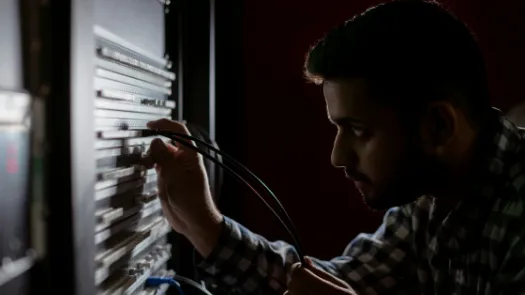Case Study: The Gig Economy and Exploitation

Gig economy jobs that depend on mobile applications allow workers’ movements to be monitored, evaluated, and exploited by their employers.
The so-called “gig economy” has brought to light employers’ increasing ability and willingness to monitor employee performance, efficiency, and overall on-the-job conduct. Workplace surveillance of gig economy workers often happens without employees’ awareness or consent. This is especially evident in the app-based gig economy, where apps act both as an important tool for employees to do their job, while also being a means for employers to conduct active surveillance of their workers.
What happened?
Historically, employers, especially in the US, UK, and Europe have possessed the right to record employee activities and other details related to experience and performance. Examples of such surveillance include requirement of employee’s criminal history, continuously acquiring employee’s health records, check-card absence that records employees working time, and monitoring of employee’s office email. Generally speaking, in the US, UK, and Europe when employees are made aware of such surveillance, the monitoring has become a normal practice. Workplace surveillance is evolving however, and in the context of the gig economy and especially in the app-based gig economy, methods of surveillance have become both cheaper and more readily available, while increasingly surveillance is occurring without the awareness of the workers.
As technology evolves and changes the way we work, it also blurs the line between our private and work life. It also enables excessive datafication of employees by employers. Technologies used to supervise employees at work can include smartphones and wearable devices, both of which could be used to supervise employees in their private life. The consequences of such monitoring are becoming visible in the gig economy.
What’s the problem?
Our phones leak traces of our activities all the time such as our location, usage patterns, and habits, and apps within our phones gain access to the vast amounts of data on our phones, including contacts, photos, and more. Employers who require employees to interface with the company via a mobile application are able to access more information about their workers than workers would initially expect.
For example, to work for the delivery company Deliveroo, workers are required to download the Deliveroo app. The app constantly records information about the device and worker, such as what kinds of routes the worker takes to a location, how often they use the application, how long they wait in a restaurant, and how long they wait outside the customer’s house.
Similar practices occur across app-based gig economy jobs, including Uber, where the company even records data about how fast the drivers accelerate and how fast they brake.
Companies benefit greatly from collecting such detailed records as it allows businesses to quickly respond to changes in environments (increasing the price of an Uber ride when demand is high) and to demand strict efficiency from their workers (monitoring how long it takes for a Deliveroo cyclist to get from point A to point B). In addition to a variety of obvious exploitative practices of the gig company, the use of mobile applications to monitor workers, is especially problematic because companies do not only collect work-related data, but inevitably also trace the movements and behaviour of their drivers whenever they use their phone.
For example, a Deliveroo driver once called the company while making the delivery to inform that his battery is running low – only to find out that the company already aware of his battery condition. The driver is not aware that such personal information from his phone is easily traceable by the employer nor that the driver gives explicit consent to the action. The amount of data collected by the employers are massive, and it is clearly not the kind of data that is usually being collected from a ‘contractor’. This example has shown that the Deliveroo app, however important, clearly give access to other information on the worker’s phone (which is often the worker’s personal device) without the awareness of the phone’s owner.
What’s the problem?
Requiring employees to use the applications as the primary manager at work means that employees are constantly carrying around a device that enables an employer to potentially know the worker’s location and activity. Workplace surveillance goes beyond monitoring productivity in the workplace, and allows employers to potentially learn deeply personal information about their workers such as their outside-of-work behaviour and characteristics. This highly granular data can be used for performance assessment and in hiring decisions.
Such monitoring is typically done without consent and sometime awareness of employees, which makes it especially problematic. How the data collected about employees is used tends to be opaque, leaving no room for employee to challenge the process.
The difficulties of challenging the surveillance and unconsent data collection practice is made worse with the precarious status of employees in gig economy. Because there is no official employment agreement between employees and employers, employees have fewer rights and protections to challenge their employers. The risk of losing their job also hinders employees to challenge the surveillance practices. Companies may argue that employees give the employers permission to collect and use the data when they begin working at the company.
Furthermore, privacy of users and employees is at risk when the data is shared with third parties, such as the government. When Uber shares data about how its cars are moving around a location with the local authorities for the sake of traffic analysis, it includes the commuting pattern of drivers as well as users. This data can potentially reveal a detailed profile of users and drivers.
There are various similar examples. The latest Uber app version enables Uber to access users’ locations until five minutes after they got off the car, even if the app is not in running in the background of the user’s phone. Another notable case involving Uber was when Apple discovered that Uber continued to collect users’ data after the app was deleted from an iPhone. This practice is known as ‘fingerprinting’; where one can identify and trace a person’s phone even after the owner deleted the application. Apple forbid application developer to use fingerprinting since it is susceptible to privacy intrusion. Uber stopped the practice after Apple threatened to wipe out Uber from its application store.
The delivery service Deliveroo also provides examples. In 2016, a Deliveroo driver was terminated because the restaurant reported him picking up food with his helmet on. Without further discussion, the company instantly terminate his contract. This example shows how the surveillance is not only performed by the employers, but also by the partners (in this case the restaurants and merchants), the public, and the customers. This detailed information about driver’s activities are being used by the employer to assess their driver, but it also puts the driver at greater risks to lose their job. As a contractor, driver is not given appropriate room for discussions if such case happened.
Other data that the company may be collecting and generating about users and for what purpose they are collecting the data remain unknown. The opacity and secrecy of such surveillance is prone to privacy intrusion, as employees and users are often not aware that their personal data is being collected, let alone being processed for specific purpose. This has shown that our devices and apps are fundamentally able to betraying us.
What is the solution?
Workplace surveillance needs to be governed by strong laws and restrictions. Since employees are financially dependent to the employer, it is questionable whether employees are ever able to truly exercise informed and unambiguous consent in the workplace. The Dutch Privacy Authority, for example, has officially prohibited companies from gathering employees’ data from wearable devices, such as fitness trackers, since it is impossible to give free consent where there is a financial dependency.
Further, our understanding of what constitutes a ‘workplace’ must be clearly defined to consider workers who do not work in a physical office and receive tasks via a mobile application. There should also be a clear definition of what constitutes an “employee” in the gig economy context, which enables workers to acquire basic employment rights and protections, including to their privacy.
Since the data that is generated by employees can be essential for the foundation of certain gig economy businesses, the capitalistic approach of data collection should be strictly regulated and controlled. The data that is generated, for what purpose, why is it necessary, and how the data processing will be conducted should be clearly disclosed to the employee. This includes all data that derives from devices and services. Furthermore, employees and regulators should be able to challenge data-driven judgements about them, in particular when these are used to inform consequential decisions about them.



